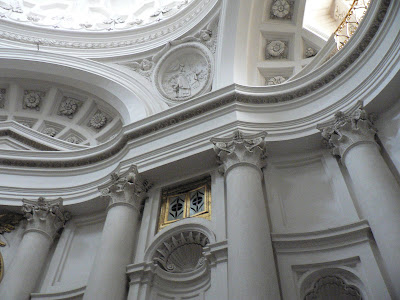
One of the buildings in this book was the big Post Office, 3 km from our apartment. I had always noticed it as a "nice" building, but after reading about it in the book I now pay particular attention every time I pass it on the bus. Adalberto Libera and Mario DeRenzi's design was the winner of a competition for a post office at the foot of the Aventine Hill, across the street from the 1st Century BC Pyramid of Cestius and the medieval Porta San Paolo,
This post office is one of the many buildings from the Fascist era in Rome. It is a travertine U-shaped building, housing three floors of offices with an enclosed oval space in the middle. This attractive stainless steel, marble and glass public hall is a form like the nearby Circus Maximus and the familiar Piazza Navona. Instead of people gathering here for races and games, people wait for postal services. I find particularly interesting the lattice-like walls of the building's side wings, the strong horizontal of the long front porch, and the view from the street of the upper level of the public hall.





Here are some pictures of a 1929 fire station across the street from the Post Office. It was built just four years before the Post Office!



















































